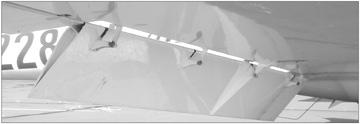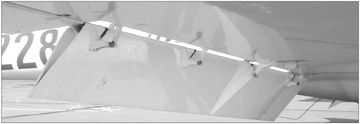
by Mike Friedman
For many pilots, wing flaps are those things we only use in the pattern; we deploy them at regular intervals when the airspeed is in the white arc as we fly a traffic pattern. Some airplanes require their use on takeoff, or for maximum-performance on less-than–ideal runways. But the many different kinds of flaps installed on personal airplanes have specific characteristics-both good ones and bad. Unless a pilot understands those characteristics and how to use the flaps properly, bad things can happen.
What Flaps Do
No matter which type of flap is installed on the airplane you fly, they work to increase lift and/or drag for any given angle of attack. Flaps, which are considered secondary control surfaces in favor of primary ones like the ailerons, rudder and elevators/stabilator, allow a compromise between high cruising speed and low landing speed, because they may be extended when needed, and retracted into the wings structure when not needed. By changing the airfoils shape and lift characteristics, flaps allow the wing to develop greater amounts of lift at low airspeeds than would otherwise be possible with a straight or flapless wing.
Usually, deploying flaps allows the airplanes wing to generate the lift required to sustain flight at a lower speed than with the flaps retracted. In some airplanes, deploying flaps adds more drag than lift. These designs depend on high power settings and increased angles of attack-often behind the airplanes power curve-to sustain level flight at low speeds.
Using Flaps For Takeoff
Few airplanes limitations prohibit using flaps on takeoff, especially when trying to achieve maximum performance, but its not always a good idea. A common error is to use flaps on a 172 when operating from a runway where a short-field technique is appropriate. The POH for a 1978 172N, for example, says, Normal and short-field takeoffs are performed with flaps up. That same POH goes on to note that no more than 10˚ of flaps may be used for takeoffs from soft or rough fields at an airspeed approximately five knots lower than with flaps up. On the other hand, a pilot flying the Skyhawks bigger brother, a 1977 182Q Skylane, for example, would apply up to 20˚ of flaps for both normal and for short/soft-field operations.
Meanwhile, the POH for a Beech A36 Bonanza manufactured before 1984 recommends not deploying flaps for takeoff. Although the airplanes POH does not include specific procedures for short- or soft-field takeoffs, neither does it prohibit them. Savvy Bonanza pilots would use a reference like John Eckalbars Flying The Beech Bonanza to come up with the best procedures for their airplane under specific conditions.
From these examples, we can draw the lesson that the extent to which, if any, a personal airplane requires flaps for takeoff involves a close review of the published documentation.
Popping Flaps On Takeoff
One technique you probably wont find in any POH is that of abruptly dropping down-or popping-the flaps late in the takeoff roll. Generally, this technique is used in an attempt to gain the best of both worlds: to minimize the drag of deployed flaps until the last moment and to suddenly change the airplanes configuration once a safe flaps-down takeoff speed is reached. You might see someone flying an underpowered floatplane with manual flaps use this technique after getting on the step. The effect would be to immediately get the airplane off the water and into the air, where the pilot can keep it in ground effect while accelerating to the best-rate-of-climb airspeed.
This technique can also be used for short-field landplane operations in aircraft with powerful manual flaps, like a Cherokee or a Maule, but, in any event, presumes a long, unobstructed takeoff path. Thats because the drag created by the deployed flaps probably will reduce the rate of climb, even though the wings are generating greater lift than they would with the flaps up.
This popping technique is not for everyone and is something you want to go out and do for the first time without the family aboard, if at all. As with any manuever, its a much better idea to practice it with plenty of dry pavement or smooth water before tryinging when it counts. Be sure to pay attention to directional control, as an abrupt liftoff after popping down the flaps might not leave you with much rudder authority. Either way, you probably wont find an airplane manufacturer formally recommend using such a technique on takeoff. Neither do we.
Using Flaps For Landing
Most of the time, youll want to use full flaps for landing. You can deploy them in stages-10˚ on downwind, another 10˚ on base and full flaps on short final-or all at once. Once you do, youre re-positioning the wings center of lift, usually aft. In turn, this change requires some nose-down elevator to prevent the airplane from getting too slow. Once the correct airspeed and power settings are set, trim off the control inputs and land the airplane.
Landing with full flaps in a crosswind can be challenging, especially when dealing with a high-wing airplane-and even worse with a high-wing taildragger. Cessnas POH for the 172N recommends using the minimum flap setting required for the field length. For grizzled veterans, this might mean full flaps-for the inexperienced CFI, it might mean no more 20˚.
Regardless of how you set your flaps for landing, dumping them-retracting your flaps as soon as the airplane is on the ground-can be a really bad idea. Inadvertently grabbing the wrong handle-gear instead of flaps is the classic example-has brought to grief numerous airplanes. The idea is to plant the airplane on the runway and, by retracting the flaps, both prevent the plane from flying again and place more weight on the wheels for enhanced braking effectiveness. Too often, though, the gear is retracted instead, and the airplane really stops short. Better to leave everything alone until the airplane comes to a stop on a taxiway, then clean it up. If you have to depend on such a technique to get even a fixed-gear airplane down and stopped, you might want to consider a longer runway.
Flap Limitations/Failures
Before you even deploy your flaps, you should be aware of any limitations imposed by the manufacturer. The most ubiquitous one is airspeed: Flap-equipped airplanes have a white arc on their airspeed indicator (ASI) denoting the speed range within which full flaps may be deployed. Depending on the airframe, this ranges upper limit may be different from the speed at which partial flaps can be used, but the partial-flap speed will not be marked on the ASI. A Cessna 182Q is a good example: No more than 10˚ of flaps may be deployed at airspeeds up to 135 KIAS, but the airplanes white arc has an upper limit of 95 KIAS.
A common limitation of Cessnas is that slips should not be performed with full flaps. Except that its not a limitation. What Cessnas POH for the 172N actually says is that steep slips should be avoided with flap settings greater than 20˚ due to a slight tendancy for the elevator to oscillate.
As simple as most flap systems are, they can and do fail. Perhaps the most common failure is a bad motor or popped circuit breaker when dealing with electric flaps or a broken linkage for the manual kind. When they fail in the retracted position, youre going to make a no-flap landing. Take a glance at the POHs emergency procedures section to make sure, but there usually isnt an issue with this kind of problem. Youll need to maintain a slightly higher speed and will use more runway. The airplane will not slow down as readily, will require less power in the pattern and likely will float in the landing flare.
The most onerous flap failure is a split-flap condition, in which one flap does not deploy to the same travel as the other. The result is a rolling moment-one wing is developing greater lift than the other. This situation demands aileron input to keep the wings level and-depending on the airplane and the condition-a higher landing speed to ensure control is maintained. The initial deployment of asymmetric flaps can be a surprise. For this reason, many instructors recommend only deploying flaps when straight and level-a steep turn near the ground is not a good place to find a split-flap condition.
Conclusion
In many ways, flaps are the Rodney Dangerfield of control surfaces-they get no respect. They are asked to perform the magic of changing the wings shape on demand, yet are often used only once each flight. A little understanding of how they work, coupled with the specific benefits of the type installed on your airplane and how the manufacturer thinks you should use them, will go a long way toward making your flying safer and more efficient.
Also With This Article
“Flap Design Types”
“Flap-Use Checklist”
-Mike Friedman is a Bonanza owner and freelance CFII living in the Washington, D.C., area.




